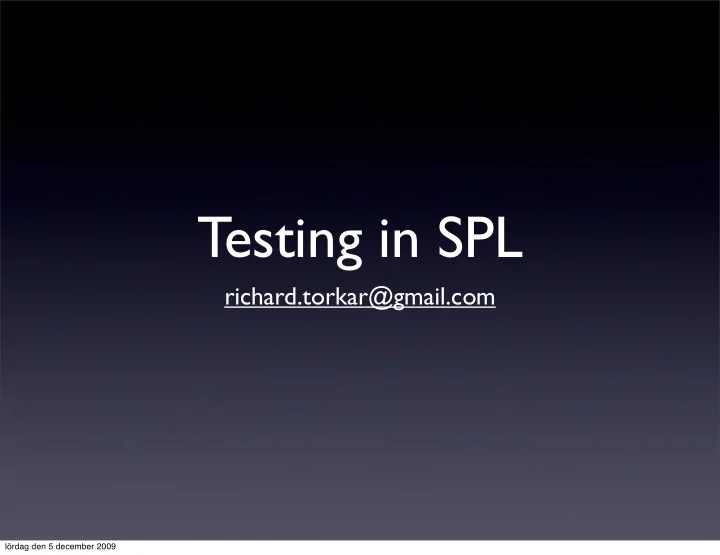

Testing in SPL richard.torkar@gmail.com lördag den 5 december 2009
lördag den 5 december 2009
Some definitions • Taken from IEEE STD 829-1998 • Test plan • Test case • Test case scenario • Test summary report lördag den 5 december 2009
Test plan • Resource consumption/allocation • Common and variable test cases to perform • Priorities (of tc) • Tool support lördag den 5 december 2009
Test plan example lördag den 5 december 2009
Test case • Test data • Test environment • Fail-pass criteria • Written in structured natural language lördag den 5 december 2009
Test case scenario • Three types • Common to all intended apps • Specific for one variant • Specific for two or more variants lördag den 5 december 2009
Test case scenario lördag den 5 december 2009
Test case scenario step • Input (specification) • Output (specification) • Execution info (guidance on how to perform the step(s)) lördag den 5 december 2009
TC scenario step lördag den 5 december 2009
TC scenario step (sequence diagram) lördag den 5 december 2009
What is different from standard SD? • Test activities are distributed between domain and individual apps • Test artefacts contain common and variable parts to be reusable • Documentation determines which variable parts to use for which config lördag den 5 december 2009
Common strategies to PLT • Brute force strategy (BFS) - perform tests at all test levels and for all possible applications during domain testing • Pure application strategy (PAS) - Perform tests only in app engineering. Only app specific tests are created and executed. No reusable domain test artefacts are created during domain testing • Sample application strategy (SAS) - Use one (or a few) sample applications to test the domain artefacts. App testing still required for each app! • Commonality and reuse strategy (CRS) - Domain testing tests common parts and prepares artefacts for testing variable parts. App testing aims at reusing test artefacts for common parts and reusing the predefined, variable domain test artefacts for test specific applications. lördag den 5 december 2009
lördag den 5 december 2009
lördag den 5 december 2009
Essential prerequisites • Dealing with variability • Variants and variation points from domain artefacts must be understood • Bind variability defined in domain artefacts with application variability model lördag den 5 december 2009
Essential prerequisites • Traceability links • Retrieve domain artefacts • App Req Spec ( • Var Model Deltas, i.e. the impact of deltas; is it worth implementing? • Traceability between domain and application → App Req Spec • Document variability point bindings defined in the domain var model → App Var Model • lördag den 5 december 2009
App var tests • Specific tests for • integration detecting issues (component focus) - connected to variability link time, load time, run-time config • Variant absence test • system - verifies (VAT) makes sure that the app does not include major system features unnecessary vars that span multiple components • unit - IFDEF • Regression tests... statements lördag den 5 december 2009
How much do we cover? • Test coverage? • Sample input domain (very much as sampling in experiments) • Variable strength array (some vars may be more likely to interact?) • Cumulative test Cohen, M. B., Dwyer, M. B., and Shi, J. 2006. Coverage and adequacy in software product line testing. In Proceedings of the ISSTA coverage 2006 Workshop on Role of Software Architecture For Testing and Analysis (Portland, Maine, July 17 - 20, 2006). ROSATEA '06. ACM, New York, NY, 53-63. DOI= http://doi.acm.org/10.1145/1147249.1147257 lördag den 5 december 2009
Q and A • Which artefacts should be tested in domain engineering and which ones in app engineering? • Generate test paths w/o variability as intermediate artefacts to test commonalities • Derive test paths for specific app instances • Derive test cases to check for presence and/or absence • Connect tests to specific app instances and create modified regression test suites lördag den 5 december 2009
Q and A (cont) • How do we facilitate the reuse of SPL test artefacts? • Explicitly define variability in domain tc • Generate test paths w/o variability as intermediate artefacts to test commonalities • Connect tests to specific app instances and create modified regression test suites lördag den 5 december 2009
Q and A (cont) • Ensuring correct variability bindings? • Test for presence and/or absence of variants in an app lördag den 5 december 2009
Things to do... • • Quality assurance? Traceability • • Integration and regression tests? Connection between domain and app • Review techniques? • Ps improvement and assessment • Model-driven development? • Using different processes for • And esp. how do we introduce different apps or, even, domains? formalism to this? • Economics • Evolution? • Predictive models (does it pay • off?) Multiple product lines and variability across these? • ROI • Tool support lördag den 5 december 2009
Thesis proposals • Currently four thesis proposals announced • Proof reuse to verify SPLs • Model-based dev of SPLs • Comparing product maps and feature diagrams • Impact of core product in ∆ -modelling • See course page for more info • Contact schaefer@chalmers.se if interested! lördag den 5 december 2009
Additions to course • Dec. 8th, 10.00, Dr. Ina Schaefer will come and present her research and talk about the possibilities students have in this field! lördag den 5 december 2009
Recommend
More recommend